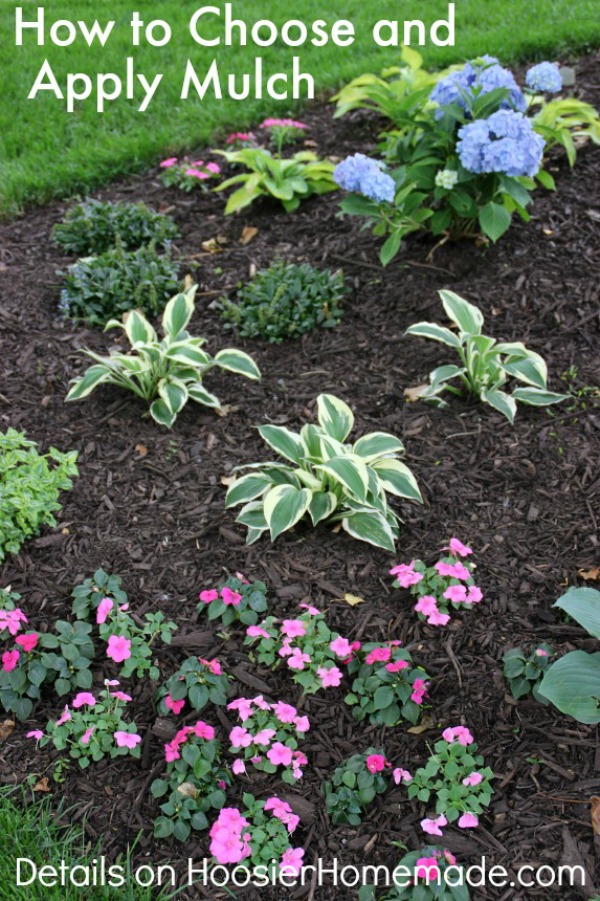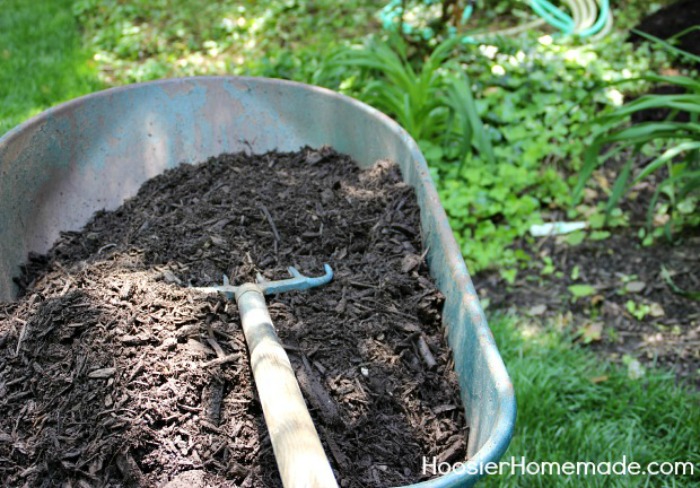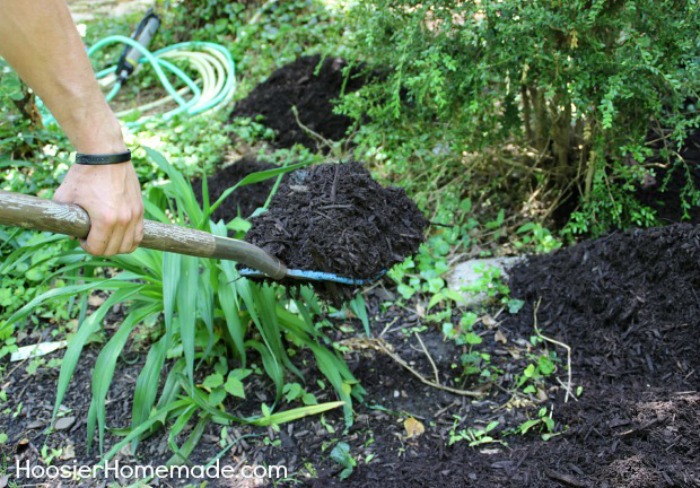How To Choose And Apply Mulch to Your Flower Beds

Knowing how to choose and apply mulch to flower beds is a good habit to get into to preserve the look and health of your landscape and flower beds. But what is mulch? Mulch simply is any material used to cover the soil surface.
Mulching your landscape is inexpensive and is one of the easiest jobs you can do as a homeowner. Mulch helps to moderate soil temperature and retain soil moisture which is good for the health of your plants. Adding a layer of mulch to your flower beds also improves the appearance of your beds and suppresses weed growth. Additionally organic mulches provide nutrients to your plants as they breakdown. Before you start it helps to understand the different types of mulch available, as well as how much mulch to use and when to apply it.
Click here for your FREE garden and landscape journal- the first step to gardening success!
What is Mulch?
Choosing Your Mulch, Organic or Inorganic
Organic and Inorganic. They both have their advantages and best places to be used. Organic mulch consists of shredded wood products which can vary in quality and consistency and comes in a variety of colors. You can also use pine needles, leaf compost and grass clipping for mulch as well. They all have unique characteristics to be aware of, pine needles tend to acidify your soil as they decompose so it is well suited for acidic soils and around plants that prefer acidic soils. Leaf compost adds nutrients to the soil that are readily available to the plants but it tends to blow around if you live in a windy location. Grass clippings are cheap and readily available but they can burn your plants as it decomposes and cause nitrogen deficiency in your plants.
Organic mulches breakdown over time releasing nutrients and enriching the soil. Normally you will need to apply organic mulches every year to maintain the look and benefits they provide to your flower beds.
Inorganic mulch consists of stone products and recycled rubber products. There are many different types of stone to choose from and many people prefer inorganic mulch for this reason alone. They also choose these to reduce problems with insects in and around the flower beds. If you choose to use inorganic mulch be aware that they will radiate heat from the sun and can cause scorching on the lower parts of your plants. There are a couple of ways to address this problem, one is to choose plants that are adapted to this or two, lay organic mulch around the base of the plant and use inorganic mulch in the areas of the flower beds where there are no plants.
Inorganic mulches are more costly initially but do not need to be replenished every year.
How much mulch do you need
All mulches need to be applied 2-4 inches thick. Mulch tends to settle over time as it decomposes so apply an inch more than you want to end up with as a final thickness. Keep in mind that if the mulch is too thin you won’t receive the benefits from using mulch such as retaining moisture and suppressing weed growth.
To determine how many cubic yards of mulch to buy, you’ll need to take a rough measurement of your flower beds in square feet. Multiply the rough size of your flower beds by how deep you want to lay your mulch. Divide this by 324 to find how many cubic yards you need to purchase. For example, if your beds measure 10 foot by 32 foot which equals 320 square feet and you want to put down a 3-inch layer of mulch, you need 3 cubic yards of mulch (320 x 3 = 960 and 960 / 324 = 3).
Bagged mulches are sold based on cubic feet. If you purchase bagged mulch to determine the number of bags you will need to do the following. Convert the depth you intend to apply your mulch from inches to feet by simply dividing by 12, the number of inches in a foot. Now multiply the depth by the area which will give you the cubic feet you need. Then simply divide the cubic feet by the size of the bag you are using. For example, let’s assume we are mulching the same area as we used above. 1o foot by 32 foot to a depth of 3 inches using 2 cubic foot sized bags (3/12 = 0.25) x (10 x 32) =80 cubic feet / 2 cubic foot sized bags = 40 bags needed.
Download our free easy reference guide
When and how to apply mulch
The best time to apply mulch is early spring before your perennials have gotten too much growth on them. This makes it easier and faster to put down the mulch and limits the damage to plants. However you can apply mulch at anytime during the year and many people in cold climate prefer to apply mulch in late fall to protect plants from winter damage such a winter burn and frost heaving.
For tools all you will need are garden gloves to protect your hands, a garden rake to spread the mulch evenly, especially in large open areas and either a scoop shovel or pitchfork for loading your wheelbarrow. Use the wheelbarrow to transport the mulch around your yard whether you are using bulk or bagged.
Spread the mulch evenly either by hand or with your garden rake. Be careful when working around plants, do not step on them and try not to damage the plants with the rake. When applying mulch next to trees, shrubs and woody perennials keep organic mulch 2-3 inches from the base of the plant. To help keep insects out of buildings stay 6 inches away from their foundations.
Controlling weeds in mulch
To help with weed control you have several options available to you. Apply a pre-emergent weed control product like Preen twice a year works well. You can also lay a layer of newspaper 4-6 sheets thick under the mulch or use landscape fabric. The newspaper will decompose and provide some additional nutrients but becomes ineffective in suppressing weeds after a couple of years and landscape fabric can keep organic debris in the mulch and provide an environment for weeds to grow after a few years plus it can make adding or transplanting additional plants troublesome.
Landscaping Questions? Here is a quick reference of information that is very helpful…



Early spring or actually before early spring when it gets warm enough to work the flower beds, can I mulch then? Will the existing plants or seeds under the dirt that come back be able to come right on out through 3 or 4″ of mulch?
Yes, you can apply the mulch as soon as weather permits. The existing plants can emerge through the mulch. You may see a little delay in emergence since the mulch can act as am insulator and slow your soil warm up.
Hi. I too am one of many who don’t know how to mulch. after much searching around I found your very informative and useful info on mulching. Thank you ever so much – your very useful info has made my mulching experience very rewarding.
So glad it was helpful Janet, thanks for stopping by and letting us know!
-Liz
What is the best mulch to use in a day lily bed. I’m looking for something that was wash away easily.
Thanks
Great question Peggy! I have had the best results with triple-ground hardwood mulch. You can use colored mulch or straight hardwood blend. The triple ground gives you the widest range of particle size, and after a few rains will settle into a nice layer that stays in place and does a great job of keeping weeds at a minimum.
This is great. But do you put the Preem down with the mulch or before the mulch?
Thanks
Carole
Hi Carole, actually, either way, it will work. I prefer to apply it to the soil surface then lay the mulch over the applied Preen.
We have just planted new flower beds and have added mulch. Will it be more difficult for new shoots from the flowers to grow through the thickness of the mulch? Thank you!
Hey Jane, Most flowers will have no problem sprouting through the mulch. There are a few of the more delicate flowers that you may want to check occasionally to see if you need to pull the mulch away from the base of the plants. An example of one would be Alyssum.
Hi I think my gardner put you much mulch and covered most of my plants begonias do you think they will still grow or they’re damaged
As long as they didn’t completely cover them they will be fine Keisha.
Hi. I am planting some spring bulbs. Can i put on top mulch?
Thank you
Hi Hilda, If you are wondering if it’s ok to go ahead and cover spring flowering bulbs that you have or are going to plant in the fall the answer is yes. Then in the spring, you can pull back the mulch to allow the soil to warm up quicker if you would like to have the bulbs get a faster start in the spring.
I’m glad that you talked about using newspaper under your mulch to try and stop weeds from growing in the future. I have been needing to start working on my new lawn, and I wasn’t sure how to use mulch in my lawn. I’ll have to try the newspaper so I can spend less time weeding in a few years.